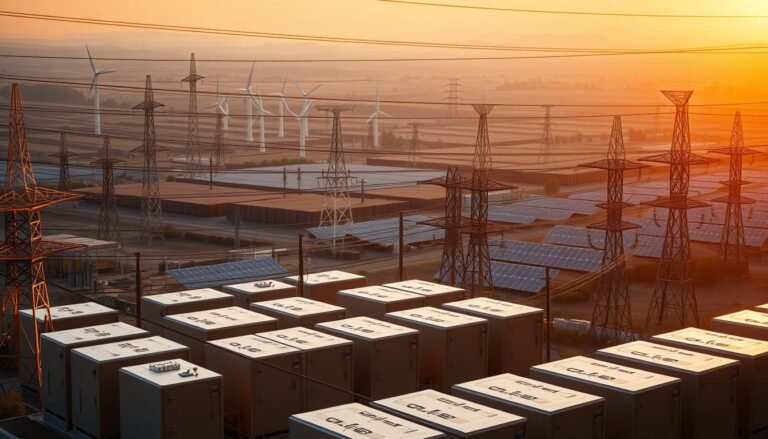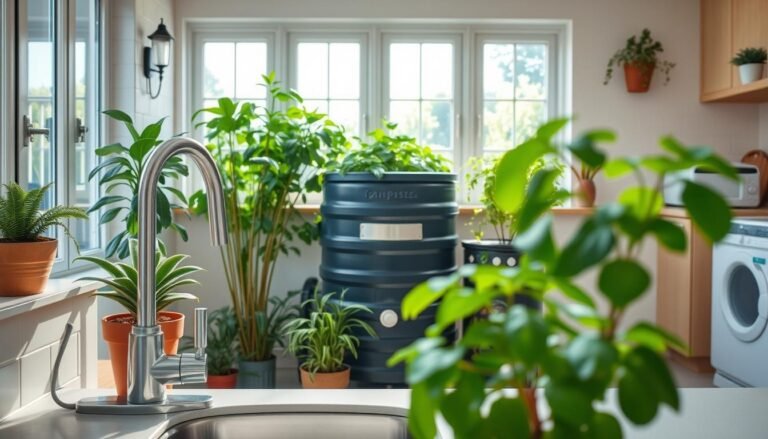The quest for renewable energy sources has intensified as the world grapples with environmental degradation and climate change. At the forefront of this mission is the development of eco-friendly batteries, which are revolutionizing the way we power our lives.
Sustainable batteries are playing a crucial role in reducing our environmental footprint. By harnessing green battery tech, we can significantly decrease our reliance on non-renewable energy sources, paving the way for a more sustainable future.
Key Takeaways
- Eco-friendly batteries are crucial for sustainable living.
- They reduce environmental impact by decreasing reliance on non-renewable energy.
- Green battery tech is advancing rapidly, offering a promising future.
- Sustainable batteries are transforming how we power our daily lives.
- The shift towards eco-friendly batteries is a key step in combating climate change.
The Environmental Impact of Traditional Batteries
Conventional batteries, while ubiquitous, pose substantial environmental risks that need to be addressed. The production and disposal of traditional batteries have far-reaching consequences, from pollution and waste to resource depletion and a significant carbon footprint.
Pollution and Waste from Disposable Batteries
Disposable batteries are a significant source of pollution. When not disposed of properly, they can leak toxic materials such as mercury, lead, and cadmium into the environment. These pollutants can contaminate soil and water, posing serious health risks to humans and wildlife. The improper disposal of batteries is a critical issue that needs to be addressed through better waste management practices and consumer education.
Resource Depletion in Battery Manufacturing
The manufacturing of traditional batteries requires the extraction of various resources, including metals like lead, nickel, and lithium. The mining of these resources can lead to resource depletion and environmental degradation. As the demand for batteries continues to grow, it is essential to consider the sustainability of these resources and explore alternatives or more efficient recycling methods.
Carbon Footprint of Conventional Battery Production
The production of conventional batteries is energy-intensive and results in a significant carbon footprint. From the extraction of raw materials to the manufacturing process, traditional battery production contributes to greenhouse gas emissions, exacerbating climate change. Efforts to reduce this carbon footprint are crucial for mitigating the overall environmental impact.
What Makes Batteries Eco-Friendly: Core Principles
The development of eco-friendly batteries is a key step in the transition to a more environmentally conscious energy sector. As the world grapples with the challenges of climate change and environmental degradation, the need for sustainable energy storage solutions has become increasingly apparent.
Defining Sustainability in Battery Technology
Sustainability in battery technology encompasses several key factors, including the use of environmentally friendly materials, efficient manufacturing processes, and minimal environmental impact throughout the battery’s lifecycle. Eco-friendly batteries are designed to reduce waste and minimize their carbon footprint.
Key Materials and Manufacturing Processes
The choice of materials and manufacturing processes plays a crucial role in determining the eco-friendliness of a battery. For instance, lithium-ion batteries have become popular due to their high energy density and efficiency. Key considerations include:
- The use of recyclable materials
- Minimizing waste in manufacturing
- Reducing the reliance on rare earth minerals
Environmental Performance Metrics
To assess the eco-friendliness of batteries, it’s essential to evaluate their environmental performance using metrics such as:
- Carbon footprint
- Energy efficiency
- Recyclability
- Toxicity of materials used
By focusing on these core principles, manufacturers can develop batteries that not only meet energy needs but also contribute to a more sustainable future.
The Evolution of Green Battery Tech in Australia
Australia is witnessing a significant shift towards green battery technology, driven by both market demand and governmental support. This evolution is crucial for the country’s transition to a more sustainable energy landscape.
Historical Development and Milestones
The journey towards green battery tech in Australia has been marked by several key milestones. Initially, the focus was on adopting existing battery technologies. Over time, the country has moved towards more innovative and sustainable solutions.
- Early adoption of lead-acid batteries
- Transition to more advanced lithium-ion technologies
- Emergence of new battery chemistries like lithium iron phosphate
Current State of the Australian Market
Today, the Australian market for green battery tech is thriving. The demand for energy storage solutions, particularly in residential solar systems, has driven growth in the industry.
Key trends include:
- Increased adoption of home energy storage systems
- Growing interest in electric vehicles
- Advancements in battery technology
Government Policies and Incentives
The Australian government has implemented various policies and incentives to support the growth of the green battery tech industry.

These include rebates for home battery installations and investments in research and development. Such initiatives have been instrumental in fostering a conducive environment for the industry’s growth.
Types of Sustainable Batteries Transforming Modern Living
Modern living is being transformed by various types of sustainable batteries that offer eco-friendly alternatives to traditional power storage solutions. These innovative batteries are not only reducing environmental impact but also enhancing the efficiency and reliability of renewable energy systems.
Lithium Iron Phosphate (LFP) Batteries
Lithium Iron Phosphate (LFP) batteries are gaining popularity due to their increased storage capacity, improved efficiency, and reduced costs. They are known for their safety, longevity, and environmental friendliness, making them an ideal choice for electric vehicles and renewable energy storage.
Key Benefits of LFP Batteries:
- Enhanced safety due to reduced risk of thermal runaway
- Longer cycle life compared to other lithium-ion batteries
- Environmentally friendly with non-toxic materials
Sodium-Ion Batteries
Sodium-ion batteries are emerging as a promising alternative to lithium-ion batteries, leveraging the abundance and low cost of sodium. These batteries are being researched for their potential to offer similar performance characteristics at a lower cost.
Advantages of Sodium-Ion Batteries:
- Abundance of sodium reduces material costs
- Potential for cost-effective production
- Similar performance to lithium-ion batteries
Zinc-Air Batteries
Zinc-air batteries represent a innovative technology that “breathes” air to generate electricity, offering a potentially higher energy density than traditional batteries. They are being explored for their application in electric vehicles and grid storage.
Characteristics of Zinc-Air Batteries:
| Feature | Description |
|---|---|
| Energy Density | Potentially higher than lithium-ion batteries |
| Cost | Could be more cost-effective due to zinc abundance |
| Rechargeability | Mechanically rechargeable by replacing zinc anodes |
Flow Batteries for Grid Applications
Flow batteries are particularly suited for grid-scale energy storage due to their ability to store large amounts of energy. They offer flexible and efficient solutions for balancing supply and demand in renewable energy grids.
Benefits of Flow Batteries:
- Scalability for large energy storage needs
- Long-duration discharge capabilities
- Flexibility in design and operation
Rechargeable Eco Batteries for Everyday Household Use
With the growing focus on sustainability, rechargeable eco batteries are emerging as a practical solution for everyday household needs. These batteries offer a more environmentally friendly alternative to traditional disposable batteries, reducing waste and minimizing environmental impact.
High-Performance Alternatives to Disposables
Rechargeable eco batteries, particularly lithium-ion batteries, provide high performance and longevity, making them suitable for a wide range of household applications, from powering toys and remote controls to serving as backup power sources for critical devices.
These batteries are designed to be reused multiple times, significantly reducing the number of batteries that end up in landfills. According to data, rechargeable lithium-ion batteries have longer lifespans than traditional lead-acid batteries, thereby reducing waste generation and environmental impact.
Long-Term Cost Benefits for Australian Consumers
While the initial cost of rechargeable eco batteries may be higher than that of disposable batteries, they offer substantial long-term cost benefits. By being able to recharge and reuse these batteries hundreds of times, Australian consumers can save money over time.
Additionally, the reduced need for frequent battery replacements can be particularly beneficial for households with high battery consumption, making rechargeable eco batteries a cost-effective solution in the long run.
Best Practices for Maximising Battery Lifespan
To get the most out of rechargeable eco batteries, it’s essential to follow best practices for their care and maintenance. This includes avoiding deep discharges, keeping batteries away from extreme temperatures, and storing them properly when not in use.
- Charge batteries when they are partially discharged.
- Avoid overcharging, as this can reduce battery lifespan.
- Store batteries in a cool, dry place.
By adopting these practices, Australian consumers can maximise the lifespan of their rechargeable eco batteries, further enhancing their cost-effectiveness and environmental benefits.
Home Energy Storage Solutions: Powering Australian Homes
With the rise of solar energy in Australia, home energy storage systems are playing a crucial role in maximizing the benefits of renewable energy. Home energy storage allows households to store excess energy generated from their solar panels, reducing their reliance on the grid and lowering their energy bills.
Integration with Residential Solar Systems
Home energy storage systems are designed to integrate seamlessly with residential solar systems. By storing excess energy generated during the day, homeowners can use it at night or during periods of low sunlight, maximizing their energy independence. This integration not only enhances the efficiency of solar energy systems but also provides a reliable backup during power outages.
Popular Models and Brands in the Australian Market
Several home energy storage solutions are popular in the Australian market, including:
- Tesla Powerwall: Known for its high capacity and sleek design.
- LG Chem RESU: Offers high-performance energy storage with a compact design.
- Sonnen ecoLinx: Provides intelligent energy management and high-capacity storage.
Installation Requirements and Considerations
Installing a home energy storage system requires careful consideration of several factors, including:
- The size of the solar panel system.
- The energy storage capacity required.
- The compatibility of the storage system with existing solar inverters.
Rebates and Incentives for Australian Homeowners
Australian homeowners can benefit from various rebates and incentives when installing home energy storage systems. These include:
- The Small-scale Renewable Energy Scheme (SRES) for eligible solar and storage systems.
- State-specific rebates and feed-in tariffs that vary across different regions.
By taking advantage of these incentives, homeowners can significantly reduce the upfront costs of home energy storage solutions, making them more accessible and affordable.
Electric Vehicles and Advanced Battery Systems
Advanced battery systems are pivotal in the growing adoption of electric vehicles worldwide. As the world shifts towards more sustainable modes of transportation, the role of electric vehicles (EVs) and their battery technologies becomes increasingly significant.
Innovations in EV Battery Sustainability
The sustainability of EV batteries is a critical area of innovation. Manufacturers are focusing on reducing the environmental impact of battery production by using more eco-friendly materials and improving recycling processes. For instance, lithium iron phosphate (LFP) batteries are gaining popularity due to their lower toxicity and enhanced safety features.
Key advancements include:
- Improved energy density
- Enhanced recycling technologies
- Use of sustainable materials
Australia’s Growing EV Charging Infrastructure
The expansion of EV charging infrastructure is crucial for the widespread adoption of electric vehicles. Australia is witnessing significant growth in this area, with numerous public and private investments being made to enhance the charging network.
| State | Number of Public Charging Stations | Growth Rate |
|---|---|---|
| New South Wales | 500 | 20% |
| Victoria | 350 | 25% |
| Queensland | 300 | 30% |
Second-Life Applications for Used EV Batteries
As the number of EVs on the road increases, so does the number of used EV batteries. Instead of being discarded, these batteries can be repurposed for second-life applications, such as energy storage systems for homes and businesses.
The benefits of second-life applications include:
- Reduced waste
- Lower costs for energy storage
- Enhanced sustainability of EV lifecycle
Large-Scale Batteries Supporting Australia’s Renewable Energy Grid
As Australia continues to shift towards renewable energy sources, large-scale batteries are playing a pivotal role in stabilizing the grid. The integration of these batteries into the national energy infrastructure is crucial for managing the variability associated with solar and wind power.
Major Grid-Scale Battery Projects Across Australia
Several significant grid-scale battery projects have been implemented across Australia to enhance the reliability of the renewable energy supply. These projects involve the installation of large-scale lithium-ion batteries that store excess energy generated during periods of low demand, which is then released during peak hours. This not only helps in balancing the grid but also reduces the strain on traditional power generation sources.
The deployment of grid-scale batteries is becoming increasingly common, with various projects underway in different states. For instance, the Hornsdale Power Reserve in South Australia is one of the most notable examples, providing grid stability and backup power when needed.
Balancing Intermittent Solar and Wind Power
One of the primary challenges with renewable energy sources like solar and wind is their intermittency. Large-scale batteries help mitigate this issue by storing energy when it’s available and releasing it when it’s needed, thus ensuring a stable power supply.
This capability is essential for maintaining grid stability and ensuring that the energy supply meets demand. By balancing the intermittency of renewable sources, large-scale batteries play a critical role in supporting Australia’s transition to a more sustainable energy mix.
Case Study: The Hornsdale Power Reserve
The Hornsdale Power Reserve, also known as the Tesla Big Battery, is a 150 MW/194 MWh lithium-ion battery facility located in South Australia. It was one of the first large-scale battery installations in the country and has since become a model for future grid-scale battery projects.
The Hornsdale Power Reserve provides grid stability, backup power, and helps in managing peak demand. Its success has demonstrated the potential of large-scale batteries in supporting renewable energy integration and enhancing grid reliability.
Innovative Materials Revolutionising Battery Production
Innovative materials are set to revolutionise battery production, offering more sustainable and efficient solutions. The development of new materials is crucial in addressing the environmental and performance challenges faced by traditional battery technologies.

Organic and Bio-Based Components
Researchers are exploring the use of organic and bio-based components in battery production. These materials, derived from renewable sources, have the potential to reduce the environmental footprint of battery manufacturing. For instance, bio-based electrolytes are being developed to replace traditional electrolytes, enhancing safety and sustainability.
Reducing Dependence on Rare Earth Minerals
The battery industry is heavily reliant on rare earth minerals, which are often associated with environmental degradation and supply chain risks. Innovative materials such as lithium iron phosphate are being adopted to reduce this dependence. Moreover, research into alternative materials like sodium and zinc is gaining momentum, offering promising substitutes for rare earth minerals.
Recycled Materials in Manufacturing Processes
The integration of recycled materials into battery production is another significant trend. Recycling not only reduces waste but also conserves resources. Closed-loop recycling systems are being developed to recover valuable materials from spent batteries, which can then be reused in new battery manufacturing, thereby reducing the demand for primary materials.
The shift towards innovative materials in battery production is a critical step towards a more sustainable and environmentally friendly energy storage industry. As research continues to advance, we can expect to see significant improvements in battery technology, driving the adoption of renewable energy sources and reducing our reliance on fossil fuels.
The Battery Recycling Ecosystem in Australia
With the rise of electric vehicles and renewable energy systems, Australia is facing a growing need for effective battery recycling solutions. As the country transitions towards a more sustainable future, the importance of developing a robust battery recycling ecosystem cannot be overstated.
Current Collection and Processing Infrastructure
Australia has made significant strides in establishing a battery recycling infrastructure. Various companies and government initiatives are working together to improve collection rates and processing capabilities. For instance, programs focusing on collecting used batteries from households and businesses are being implemented across major cities.
The current infrastructure includes several key facilities that are equipped to handle different types of batteries, including lead-acid, lithium-ion, and nickel-metal hydride batteries. These facilities are crucial for ensuring that batteries are recycled in an environmentally responsible manner.
Challenges in Battery Waste Management
Despite the progress made, Australia’s battery recycling ecosystem faces several challenges. One of the primary issues is the lack of standardized collection systems across different regions, which can lead to confusion among consumers and businesses about how to properly dispose of used batteries.
Another significant challenge is the economic viability of recycling certain types of batteries, particularly lithium-ion batteries, which are complex and costly to recycle. Addressing these challenges will be crucial for improving the overall efficiency of the battery recycling ecosystem.
Consumer Participation in Recycling Programs
Consumer participation is a critical factor in the success of battery recycling programs. Educating the public about the importance of recycling batteries and making it convenient for them to do so are key strategies. Public awareness campaigns and drop-off locations at retail stores and community centers can significantly enhance consumer participation.
By engaging consumers and providing accessible recycling options, Australia can increase its battery recycling rates and move closer to achieving a circular economy for battery materials.
Economic Benefits of Sustainable Battery Technologies
Australia is on the cusp of an economic revolution driven by the adoption of sustainable battery technologies. The country’s commitment to renewable energy and reducing carbon emissions is creating a fertile ground for the growth of this industry.
Job Creation in Green Manufacturing Sectors
The sustainable battery industry is expected to create numerous job opportunities in manufacturing, research, and development. As the demand for eco-friendly batteries continues to rise, Australian businesses are investing heavily in production facilities and hiring skilled workers to meet this demand.
Energy Independence and Cost Savings
Sustainable battery technologies are not only environmentally friendly but also offer significant economic benefits, including energy independence and cost savings. By harnessing renewable energy and storing it efficiently, households and businesses can reduce their reliance on the grid and lower their energy bills.
Australia’s Potential as a Global Battery Innovation Hub
Australia has the potential to become a global leader in battery innovation, leveraging its rich resources, research capabilities, and commitment to sustainability. By fostering a supportive ecosystem for startups and established companies alike, Australia can attract investment, talent, and expertise from around the world.
The economic benefits of sustainable battery technologies are multifaceted, ranging from job creation to energy independence. As Australia continues to invest in this sector, it is poised to reap significant rewards and become a global hub for battery innovation.
Overcoming Barriers to Eco-Friendly Battery Adoption
With the Australian government tightening regulations on battery recycling, including Extended Producer Responsibility (EPR) policies, the need to overcome barriers to eco-friendly battery adoption has never been more pressing. As the country moves towards a more sustainable future, understanding and addressing the challenges associated with eco-friendly batteries is crucial.
Addressing Initial Cost Concerns
One of the primary barriers to the adoption of eco-friendly batteries is the higher initial cost compared to traditional batteries. However, it’s essential to consider the long-term benefits and cost savings that eco-friendly batteries offer, such as longer lifespans and reduced maintenance needs.
Technical Limitations and Research Needs
Technical limitations, such as energy density and charging times, are also significant barriers. Ongoing research and development are necessary to improve these aspects and make eco-friendly batteries more competitive with their conventional counterparts.
Improving Consumer Education and Awareness
Consumer education plays a vital role in the adoption of eco-friendly batteries. By increasing awareness about the benefits, proper use, and recycling of these batteries, consumers can make more informed decisions, driving demand for sustainable battery technologies.
In conclusion, overcoming the barriers to eco-friendly battery adoption requires a multifaceted approach that includes addressing cost concerns, advancing technology, and enhancing consumer education. As Australia continues to lead in sustainable practices, the successful adoption of eco-friendly batteries will be a significant step towards a greener future.
Future Innovations in Sustainable Battery Technology
As the world shifts towards renewable energy, sustainable battery technology is evolving rapidly. The need for more efficient, safer, and environmentally friendly batteries is driving innovation across the globe.
Emerging Research from Australian Universities
Australian universities are at the forefront of battery technology research. Institutions are exploring new materials and designs that could significantly improve battery performance and sustainability. For instance, researchers are investigating the potential of solid-state batteries, which promise higher energy density and enhanced safety.
Solid-State Battery Development
Solid-state batteries are being developed to replace the liquid electrolyte in traditional lithium-ion batteries with a solid material. This innovation could lead to batteries that are not only more efficient but also safer, as they reduce the risk of fires and explosions. Companies and researchers worldwide are racing to bring this technology to market.
AI-Powered Battery Management Systems
Another significant advancement is the integration of AI-powered management systems in battery technology. These systems optimize battery performance, predict maintenance needs, and can significantly extend the lifespan of batteries. By leveraging AI, manufacturers can improve the overall efficiency and reliability of battery systems.
Biodegradable Battery Options
Researchers are also exploring the development of biodegradable batteries, which could reduce electronic waste and minimize environmental impact. These batteries are designed to break down naturally at the end of their life cycle, offering a potentially revolutionary solution for sustainable energy storage.
The future of sustainable battery technology looks promising, with ongoing research and development set to address current limitations and unlock new possibilities for energy storage and usage.
Conclusion: Powering a Sustainable Future with Eco-Friendly Batteries
As the world shifts towards renewable energy sources, eco-friendly batteries are playing a crucial role in powering a sustainable future. By reducing the environmental impact of energy storage, these innovative batteries are facilitating the widespread adoption of clean energy technologies.
Eco-friendly batteries are revolutionising sustainable living by providing efficient, reliable, and clean energy storage solutions. From residential homes to grid-scale applications, these batteries are transforming the way we consume and store energy.
The future of sustainable living in Australia looks promising, with ongoing research and development in eco-friendly battery technologies. As the demand for clean energy continues to grow, the importance of eco-friendly batteries will only continue to increase, driving us towards a more sustainable future.





